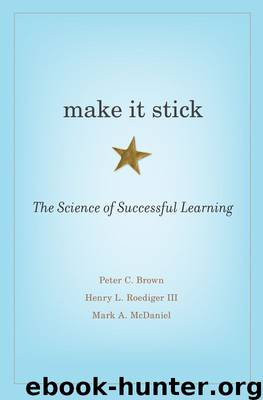Make It Stick by Brown Peter C

Author:Brown, Peter C. [Brown, Peter C.]
Language: eng
Format: epub
Publisher: Harvard University Press
Published: 2014-04-14T00:00:00+00:00
Rule versus Example Learning
Another cognitive difference that appears to matter is whether you are a “rule learner” or “example learner,” and the distinction is somewhat akin to the one we just discussed. When studying different kinds of problems in a chemistry class, or specimens in a course on birds and how to identify them, rule learners tend to abstract the underlying principles or “rules” that differentiate the examples being studied. Later, when they encounter a new chemistry problem or bird specimen, they apply the rules as a means to classify it and select the appropriate solution or specimen box. Example learners tend to memorize the examples rather than the underlying principles. When they encounter an unfamiliar case, they lack a grasp of the rules needed to classify or solve it, so they generalize from the nearest example they can remember, even if it is not particularly relevant to the new case. However, example learners may improve at extracting underlying rules when they are asked to compare two different examples rather than focus on studying one example at a time. Likewise, they are more likely to discover the common solution to disparate problems if they first have to compare the problems and try to figure out the underlying similarities.
By way of an illustration, consider two different hypothetical problems faced by a learner. These are taken from research into rule learning. In one problem, a general’s forces are set to attack a castle that is protected by a moat. Spies have learned that the bridges over the moat have been mined by the castle’s commander. The mines are set to allow small groups to cross the bridges, so that the occupants of the castle can retrieve food and fuel. How can the general get a large force over the bridges to attack the castle without tripping the mines?
The other problem involves an inoperable tumor, which can be destroyed by focused radiation. However, the radiation must also pass through healthy tissue. A beam of sufficient intensity to destroy the tumor will damage the healthy tissue through which it passes. How can the tumor be destroyed without damaging healthy tissue?
In the studies, students have difficulty finding the solution to either of these problems unless they are instructed to look for similarities between them. When seeking similarities, many students notice that (1) both problems require a large force to be directed at a target, (2) the full force cannot be massed and delivered through a single route without an adverse outcome, and (3) smaller forces can be delivered to the target, but a small force is insufficient to solve the problem. By identifying these similarities, students often arrive at a strategy of dividing the larger force into smaller forces and sending these in through different routes to converge on the target and destroy it without setting off mines or damaging healthy tissue. Here’s the payoff: after figuring out this common, underlying solution, students are then able to go on to solve a variety of different convergence problems.
Download
This site does not store any files on its server. We only index and link to content provided by other sites. Please contact the content providers to delete copyright contents if any and email us, we'll remove relevant links or contents immediately.
| Administration | Assessment |
| Educational Psychology | Experimental Methods |
| History | Language Experience Approach |
| Philosophy & Social Aspects | Reform & Policy |
| Research |
The Art of Coaching Workbook by Elena Aguilar(51071)
Trainspotting by Irvine Welsh(21564)
Twilight of the Idols With the Antichrist and Ecce Homo by Friedrich Nietzsche(18564)
Fangirl by Rainbow Rowell(9172)
Periodization Training for Sports by Tudor Bompa(8209)
Change Your Questions, Change Your Life by Marilee Adams(7676)
This Is How You Lose Her by Junot Diaz(6830)
Asking the Right Questions: A Guide to Critical Thinking by M. Neil Browne & Stuart M. Keeley(5705)
Grit by Angela Duckworth(5553)
Red Sparrow by Jason Matthews(5422)
Paper Towns by Green John(5136)
Room 212 by Kate Stewart(5067)
Ken Follett - World without end by Ken Follett(4681)
Housekeeping by Marilynne Robinson(4390)
The Sports Rules Book by Human Kinetics(4339)
Double Down (Diary of a Wimpy Kid Book 11) by Jeff Kinney(4239)
Papillon (English) by Henri Charrière(4223)
The Motorcycle Diaries by Ernesto Che Guevara(4046)
Exercise Technique Manual for Resistance Training by National Strength & Conditioning Association(4016)
